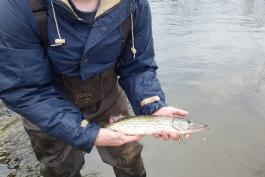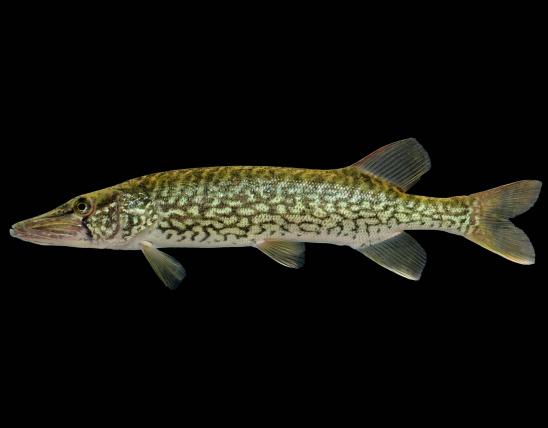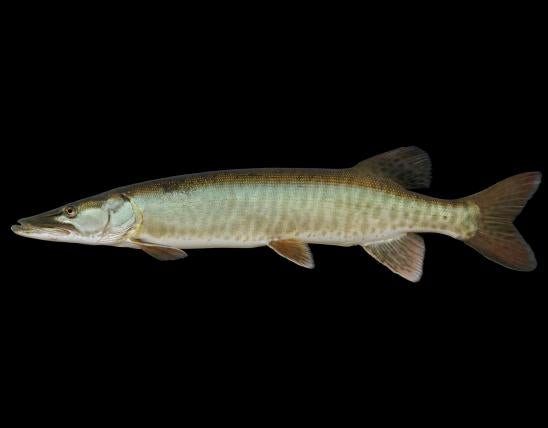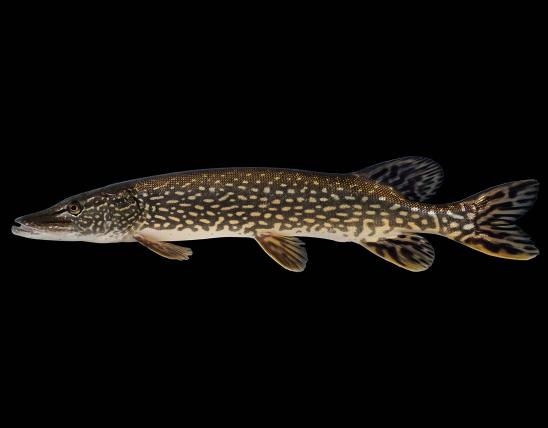
Like other pikes, the grass pickerel has a duckbill-shaped snout, large mouth with many sharp teeth, and a single dorsal fin, which is similar in shape and size to the anal fin, and both are positioned far back, near the forked tail fin. Like the chain pickerel, it has both the gill cover and the cheek fully scaled, with a row of 4 sensory pores along the undersurface of the jaw, but the snout is shorter than the chain pickerel’s, and the distance from tip of snout to center of eye is equal to or less than the distance from the center of the eye to the rear margin of the gill cover. The back and sides are olive or yellowish brown, sometimes uniformly colored, but often barred or mottled with a darker color. A dusky bar angles downward and slightly backward from the eye.
Similar species: There are two subspecies of Esox americanus. The subspecies that occurs in Missouri is Esox americanus vermiculatus, officially called the grass pickerel. The other subspecies is the nominate one: Esox americanus americanus; it is officially named the redfin pickerel, it has red fins, and it does not occur in Missouri (it is found in rivers along the Atlantic coast, south to Georgia). Because, at the species level, the common name defaults to that of the nominate subspecies, it's not incorrect to call any member of species Esox americanus a "redfin pickerel," but since we have a distinct subspecies with a different (and more fitting) name in our state, it's more precise to call ours the grass pickerel.
Length: seldom exceeds 10-12 inches, with a maximum of about 14 inches; weight: to 3/4 pound.

The most common and widely distributed pike in Missouri; common in the Bootheel lowlands as well as in some streams of the southern and eastern Ozarks. It does not seem to inhabit the Missouri River tributaries in our state. Recorded in the Mississippi River as far north as Lincoln County.
Habitat and Conservation
Prefers clear water, little current, and thick growths of aquatic vegetation. In the Southeastern Lowlands, this fish frequents natural lakes, sloughs, borrow pits, and the sluggish sections of ditches and streams. In the Ozarks, it is usually found in small headwater creeks having large, permanent pools but little flow during much of the year and in the spring pools, protected inlets, and overflow waters along major streams.
Food
Like other pikes, this species is carnivorous and hunts by ambush, darting out to seize prey from a place of concealment. Young grass pickerels eat small crustaceans, amphipods, isopods, and young aquatic insects. Larger pickerels eat small fish, crayfish, and dragonfly nymphs. Large individuals eat mainly fish and crayfish, including darters and (for pickerels more than 7 inches long) sunfish.
Status
In the southeastern Ozarks, this game fish's presence alternates with that of the chain pickerel, with one or the other predominating at any one locality.
Life Cycle
Spawning in our state occurs in late February and early March, and possibly also in late fall or early winter. The eggs are broadcast over submerged vegetation without preparation of a nest. There is no parental care of the eggs or young. At the end of the first year, they are probably about 4 inches long, then about 8 and 10 inches in succeeding years. Females grow faster and live longer than males. Grass pickerels rarely live more than 3 or 4 years.
Human Connections
Although northern pike and muskellunge reach large sizes and are esteemed as game fishes, the grass pickerel seldom reaches a size to be of interest to fishers. Their sleek, muscular, torpedo-shaped bodies, with fins positioned in the back for quick bursts of speed, perfect for their lie-in-wait predatory biology, is worthy of admiration.
Ecosystem Connections
Members of the pike family are important predators in aquatic ecosystems, serving to limit populations of nongame fishes that might become too large to be consumed by other common predators, such as basses.




























